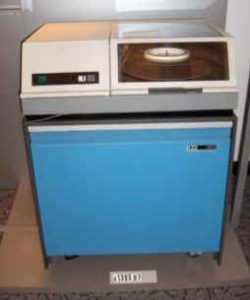IBM magnetic disk storage family
International Business Machines Co. ( IBM ) has been manufacturing removable magnetic disk data storage devices for its various computers since 1962, starting with the drive code 1311 (pictured) described below – colloquially nicknamed the “washing machine” due to its shape – which was capable of storing two million characters on the IBM 1316 magnetic disk.
However, the development did not stop, the successor of the 1311 was the 2302 and 2305, which were already in byte system and adapted to the 360 computer family, followed by the long-lived 7.25 MB capacity 2311, which also became the model of the ESZR. The peak was represented by the 2314, each with a capacity of 30 MB – mocked as a “pizza oven” after its cabinet and drawer design.
Use
Machine-independent storage of large amounts of data
They worked alongside various IBM computers, although the 1311 model was originally used with the IBM 7000 and IBM 1400 computer systems.
In Hungary, the first copy was purchased by the Ministry of Metallurgy and Mechanical Industry , KGM, for its 1440 computer.
Structure
The drive spun the disk pack (IBM 1316) around a vertical axis at a speed of 1500 rpm, which consisted of six 36 cm diameter disk platters, on which 10 disk sides were used for data recording.
The read/write heads extended between the platters on a common horizontal axis and read and wrote data in circular tracks. The width of the tracks was determined by the size of the heads and their spacing by the position of the heads, which was adjusted by a stepper motor.
There were two types of drives: the primary-type ones were about 30 cm wider than the secondary ones because they contained the control unit and power supply necessary for joint operation.
The disk pack was covered by a plastic cover that fitted onto the lower platter. The pack could be lifted off the platter by turning the lever on top of the cover and lowered (from the cover) onto the vertical axis of the drive, then secured by turning the lever back.
The data transfer speed was largely determined by the time required to position the read/write heads.
Operation
Upon startup — after the disk pack was properly inserted — the disk magazine lid closed automatically and the pressurized air created by blowing air created an air cushion between the read/write heads and the disks, preventing unwanted friction.
Each disk side had 100 data tracks, each divided into 20 sectors, and each sector had 100 character locations; thus, a total of 2 million characters could be stored on a disk pack — but the number of disk packs was unlimited.
Data storage and retrieval could be done in four ways:
- Direct seek: the heads automatically returned to track 0 (table of contents) after each seek operation, which was only accessible by the operating system
- Quick scan: quickly scan the disk to search for identifiers or conditions
- Overlapping search: sequential execution of a search and then a write/read instruction after a hit
- Stripe writing: writing data to a stripe as a single record instead of sectors, to increase storage capacity
More details about the operation: IBM 1311 (with video)
Program set
The data storage controller was controlled by the operating system at the time.
There were no
Historical curiosities
This was the first magnetic disk storage device that allowed for "offline" data storage by easily replacing the disks, taking up relatively little space. However, during replacement and storage, extra care had to be taken to ensure a dust-free environment, as the disks could easily become electrostatically contaminated.
They also had great advertising value because the disk packages were only compatible with IBM-made drives, so they steered users towards them.
Resources
History of IBM magnetic disk storage (English)
Created: 2016.07.17. 22:50
Last modified: 2021.10.22. 14:21

